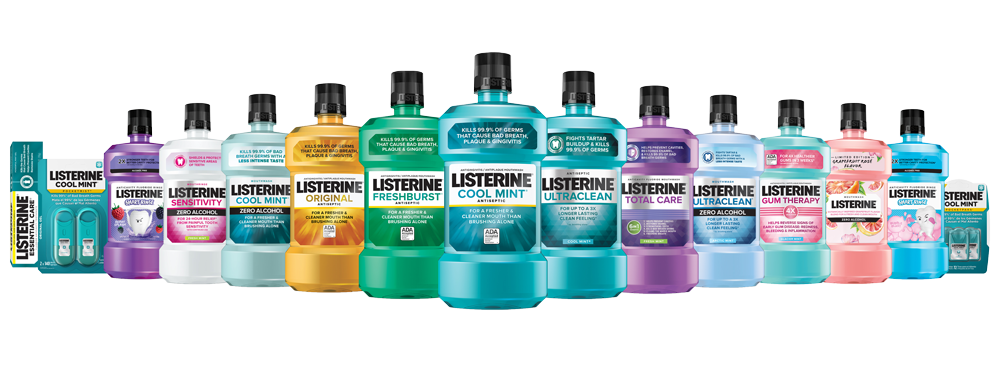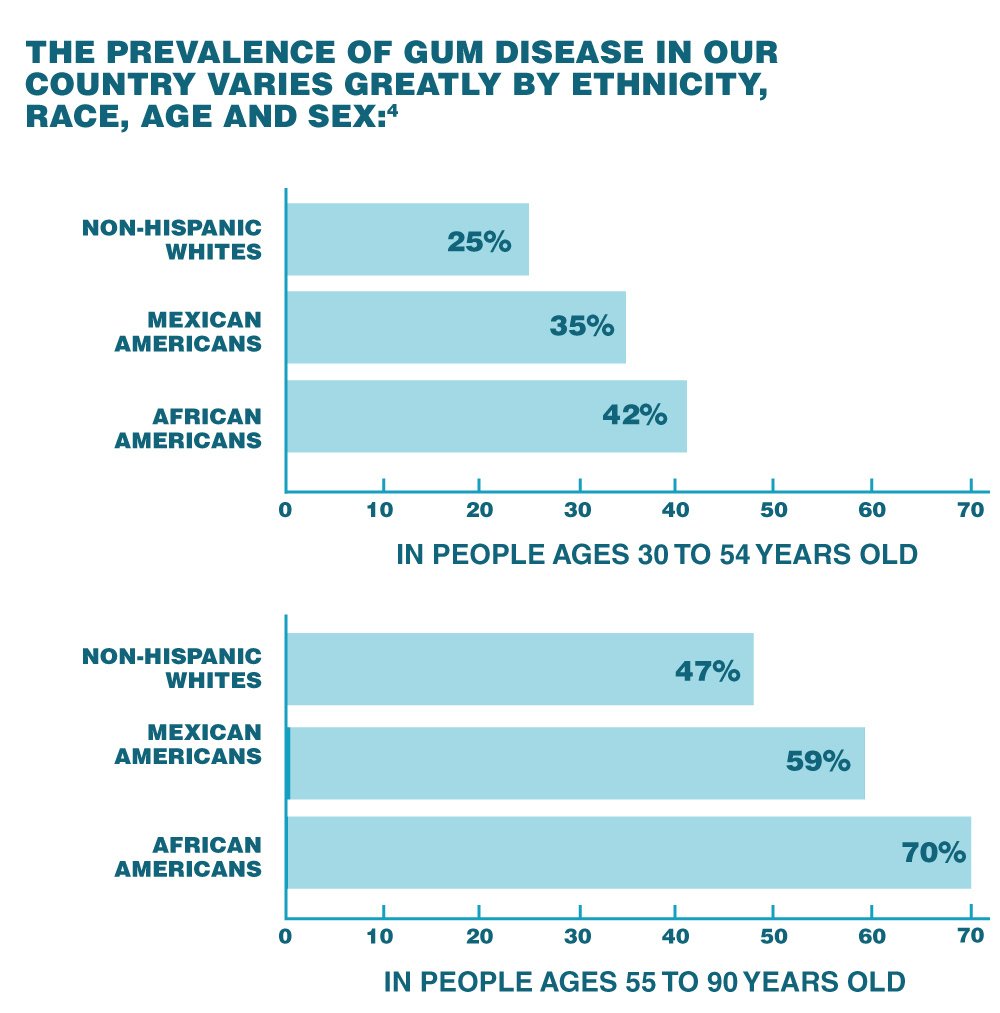


Licensed professionals can receive the latest Listerine clinical information and patient resources.

IMPORTANT INSIGHTS THAT CAN AFFECT HOW YOU TREAT GUM DISEASE.
You would think that with today’s focus on oral healthcare, good brushing and flossing habits, and breakthroughs in dental treatments and technology, gum disease should be diminished.
But the fact is, chronic gingivitis actually affects over 90% of the world population to some degree. And, it’s prevalent at all ages.2

As you know, gingivitis is the first stage of gum disease. As dental plaque builds up on the gum line, bacteria in the plaque causes inflammation of the gums. The good news is that, with proper care, gingivitis is easily treated and can be completely reversed—as well as prevented with the help of a daily oral health regimen that includes brushing, flossing, and rinsing.
But as you’re also aware, periodontitis is the next, much more serious stage of gum disease that can occur when gingivitis isn’t properly treated—and can ultimately result in tooth loss. And, it’s not reversible.* About 64.7 million adults in the US have periodontitis, with 30% at a moderate stage of the disease, and 8.5% at an advanced stage.3
Click here to see evidence from the Journal of Dental Research showing the prevalence of adult periodontitis in the US.3

Men are more likely to be affected by gum disease than women.5
Of course, many other factors can come into play in the occurrence of gum disease—such as lifestyle, education level, socioeconomic status, cultural influences, values, and practices.5-9
What more can you do to help?
But what about modifiable behaviors? The value and importance of talking to your patients to learn more about their lifestyle and family health/disease history cannot be underestimated as a way to make positive changes in their oral health habits and lifestyle behavior.
An extended period of alcohol abuse can damage gums and teeth.12 Encouraging patients to quit smoking and lessen their alcohol intake could help reduce their risk of developing gum disease.
A diet high in sugary foods and carbohydrates and low on water intake can also increase the likelihood of plaque formation. Plus, deficiencies in important nutrients, such as vitamin C, can impair healing.13 Here is where light nutrition counseling and calling attention to the benefit of hydration can be beneficial.
Stress can also play a role in triggering or worsening gum disease as it causes the body to release inflammatory hormones. Also, when feeling stressed, people are less likely to take good care of their health—which includes brushing and flossing.14
And then there’s diabetes. Because diabetes affects the body’s ability to use blood sugar, patients with this disease are at higher risk of developing infections, including gum disease.15 Reminding your patients with diabetes that poor glycemic control also affects their oral health is an important component of their overall well-being.
Other factors that can increase the risk of gum disease include genetics and family history, an immune system compromised by cancer or HIV, certain medications, and the one factor that most of your patients will face at some point: aging.15,16
Having a clearer understanding of who has gum disease and the various factors that come into play can inform how you counsel your patients about modifying behaviors that are detrimental to their oral health. It can also help you devise an individualized treatment strategy for each and every patient.
We hope you found this article of value.
LISTERINE® AND THE REDUCTION OF PLAQUE AND GINGIVITIS.
Read evidence from a study about LISTERINE® Antiseptic and the reduction of existing plaque and gingivitis.
LISTERINE® & 4 ESSENTIAL OILS.
Discover the unique combination of 4 ESSENTIAL Oils designed to combat plaque and gingivitis.
THE DEMOGRAPHICS OF GUM DISEASE. Footnotes
*LISTERINE® Antiseptic is not indicated to treat periodontitis.
References: 1. Eke PI, Dye BA, Wei L, et al. Update on Prevalence of Peridontitis in Adults in the United States: NHANES 2009 and 2012. J Periodontal. 2015;86(5):611-622. 2. Coventry J, Griffiths G, Scully C, Tonetti M. Periodontal disease. BMJ. 2000;321(7252):36-39. 3. Eke PI, Dye BA, Wei L, et al. Prevalence of peridontitis in adults in the United States: 2009 and 2010. J Dent Res. 2012;91(10):914-920. 4. Ethnicity and Periodontal Health. American Academy of Periodontology Patient Page. 2001;2(5):1. 5. Centers for Disease Control and Prevention. Periodontal disease. http://www.cdc.gov/OralHealth/periodontal_disease/index.htm. Accessed December 17, 2015. 6. Gundala R, Chava VK. Effect of lifestyle, education and socioeconomic status on periodontal health. Contemp Clin Dent. 2010;1(1):23-26. https://www.ncbi.nlm.nih.gov/pmc/articles/PMC3220063/. Accessed December 17, 2015. 7. Borrell L, Beck JD, Heiss G. Socioeconomic disadvantage and periodontal disease: the dental atherosclerosis risk in communities study. Am J Pub Health. 2006;96(2):332-339. 8. Carteret M. How culture affects oral health beliefs and behaviors. Dimensions of Culture. http://www.dimensionsofculture.com/2013/01/how-culture-affects-oral-heal.... Accessed December 17, 2015. 9. National Institute of Dental and Craniofacial Research. Oral health in America: a report of the Surgeon General (executive summary). http://www.nidcr.nih.gov/DataStatistics/SurgeonGeneral/Report/ExecutiveS.... Accessed December 17, 2015. 10. WebMD. The health perils of gum disease. http://www.webmd.com/oral-health/features/health-perils-of-gum-disease?p.... Accessed December 17, 2015. 11. American Dental Hygienists’ Association. Want some life saving advice? Ask your dental hygienist about tobacco use and periodontal disease. 2010:1-2. 12. American Academy of Periodontology. Study: alcohol consumption can have a negative impact on gum health. https://www.perio.org/consumer/alcohol-negative-effect-on-gum-health. Accessed December 17, 2015. 13. Horne SB. Gum disease (gingivitis). MedicineNet. https://www.medicinenet.com/gum_disease/article.htm#what_causes_gum_disease. Accessed December 17, 2015. 14. WebMD. Stress may wreak havoc on your mouth. http://www.webmd.com/oral-health/news/20070813/stress-may-wreak-havoc-on.... Accessed December 27, 2015. 15. WebMD. Gingivitis and periodontal disease (gum disease). https://www.webmd.com/oral-health/guide/gingivitis-periodontal-disease. Accessed December 17, 2015. 16. Mayo Clinic. Gingivitis. Risk factors. http://www.mayoclinic.org/diseases-conditions/gingivitis/basics/risk-fac.... Accessed May 25, 2016.
*NOTE: Links to other parties’ Web sites are provided solely for convenience. Johnson & Johnson Consumer Inc. is not responsible for the content of such Web sites, and users are solely responsible for compliance with any terms of use thereon. In addition, such links to third-party sites does not imply an endorsement of any third party or any Web site or the products or services provided by any third party.





All Fields required, unless otherwise indicated
Personal Information
Step 1
Will be used as your user name
By submitting your information above, you agree that the information you provide will be governed by our site's Privacy Policy.